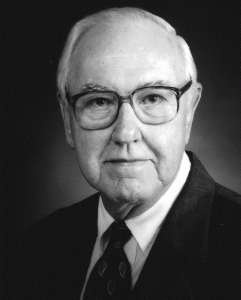This post is part of The Plank Center’s Legacies from Legends in PR Series that was begun in recognition of the 40th Anniversary of the Public Relations Student Society of America in 2007.
Edward Block led public relations, employee information and advertising programs at AT&T for 12 years. Established the AT&T charitable foundation. Retired as the Senior Vice President of Public Relations at AT&T. Helped develop the initiative that led AT&T to establish the MacNeil-Lehrer NewsHour on PBS. Recipient of the PRSA Gold Anvil Award (1997), the Arthur W. Page Hall of Fame Award (1993) and the Alexander Hamilton Medal of the Institute for Public Relations (2003).
There are two basic building blocks for a successful career in public relations. You discover them through experience over time, hopefully with help from mentors or role models. That was my good fortune.
The two building blocks are brains and guts.
If this strikes you as too glib to be a useful nugget of knowledge, just think about it.
Brains are your software, the stuff you’ll need to intimately understand the business of your employer or client, the ability to think clearly, often under pressure, often without useful guidance from your boss and, most important from day one, your source of creativity and passion to demonstrate superb craftsmanship as a writer.
Guts are your hardware, a willingness to tactfully stick to your guns when you’ve thought through an issue or problem, understand what’s at stake and exhibit confidence that you know what needs to be done or said when others do not or won’t stick their necks out. You won’t prevail every time, but you’ll build a reputation for always being fully invested in your responsibilities.
Over a long career I’ve heard these simple rules expressed in different words by other successful executives:
- Bosses don’t want to know how smart you are, they want timely, responsive solutions to the issues they confront.
- Bosses want solutions, not problems. They’ve got enough of the latter.
- Timid sycophants are useless.
- If you screw up, be the first one to tell the boss what happened and what you intend to do about it.
What this advice adds up to is that leadership and success begin with brains and guts. These characteristics and how to employ them emerge over time as opportunities come your way to demonstrate them. Not likely on your first day on a new job, but certainly beginning, at least in small ways, with your first job.
A wise friend once told me that the very best business schools cannot teach a CEO how to be an effective CEO. They must learn on the job. The same holds true for men and women who pursue careers in public relations. A good school can help you master the tools and techniques of effective public relations, but it’s on the job that you master the art of public relations management.
So, be patient, seek out and pay attention to role models, learn the business of your business and, as your career advances, learn how to become the “go to” person when business problems threaten management goals. In the business world, communication is overhead. Problem-solving is value added. PR possesses unique assets to help management recognize, understand and solve problems.
Published: 2007
* Deceased (1927-2016)

